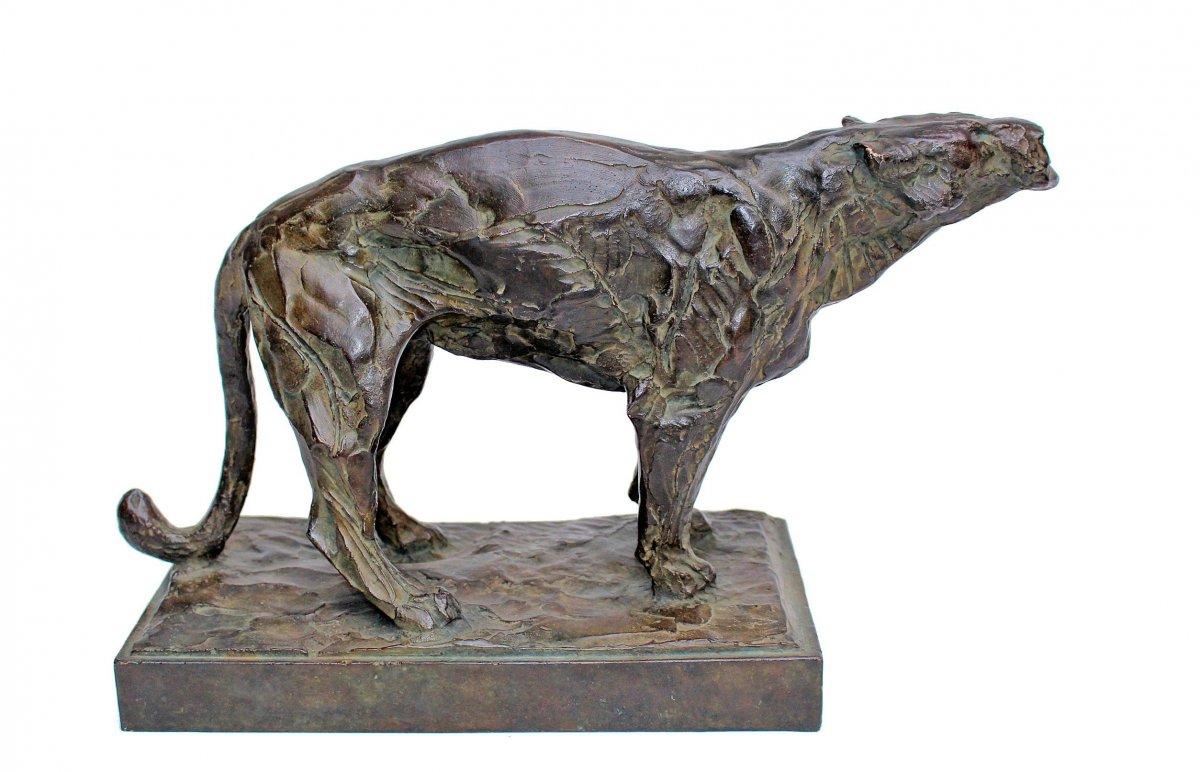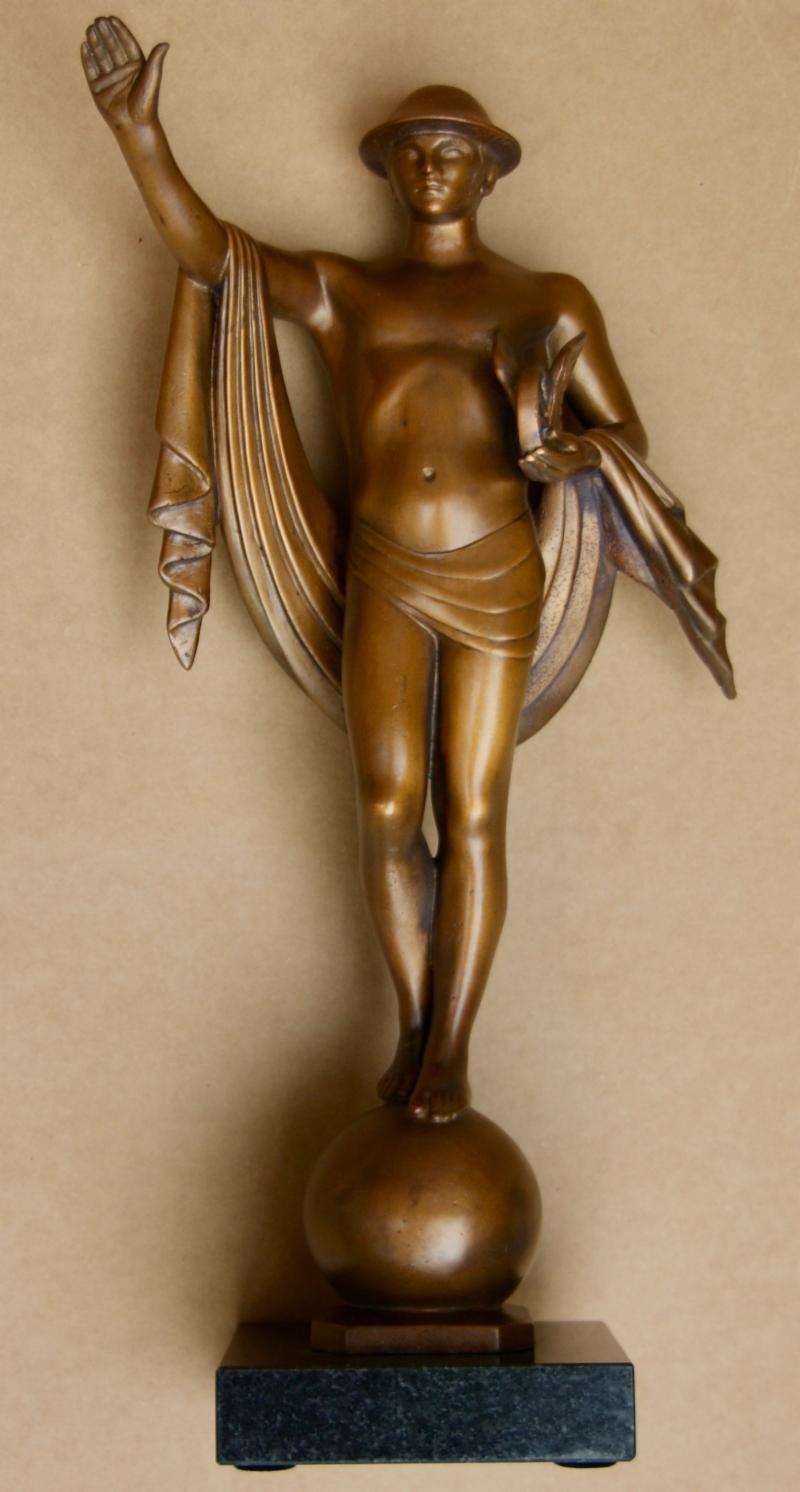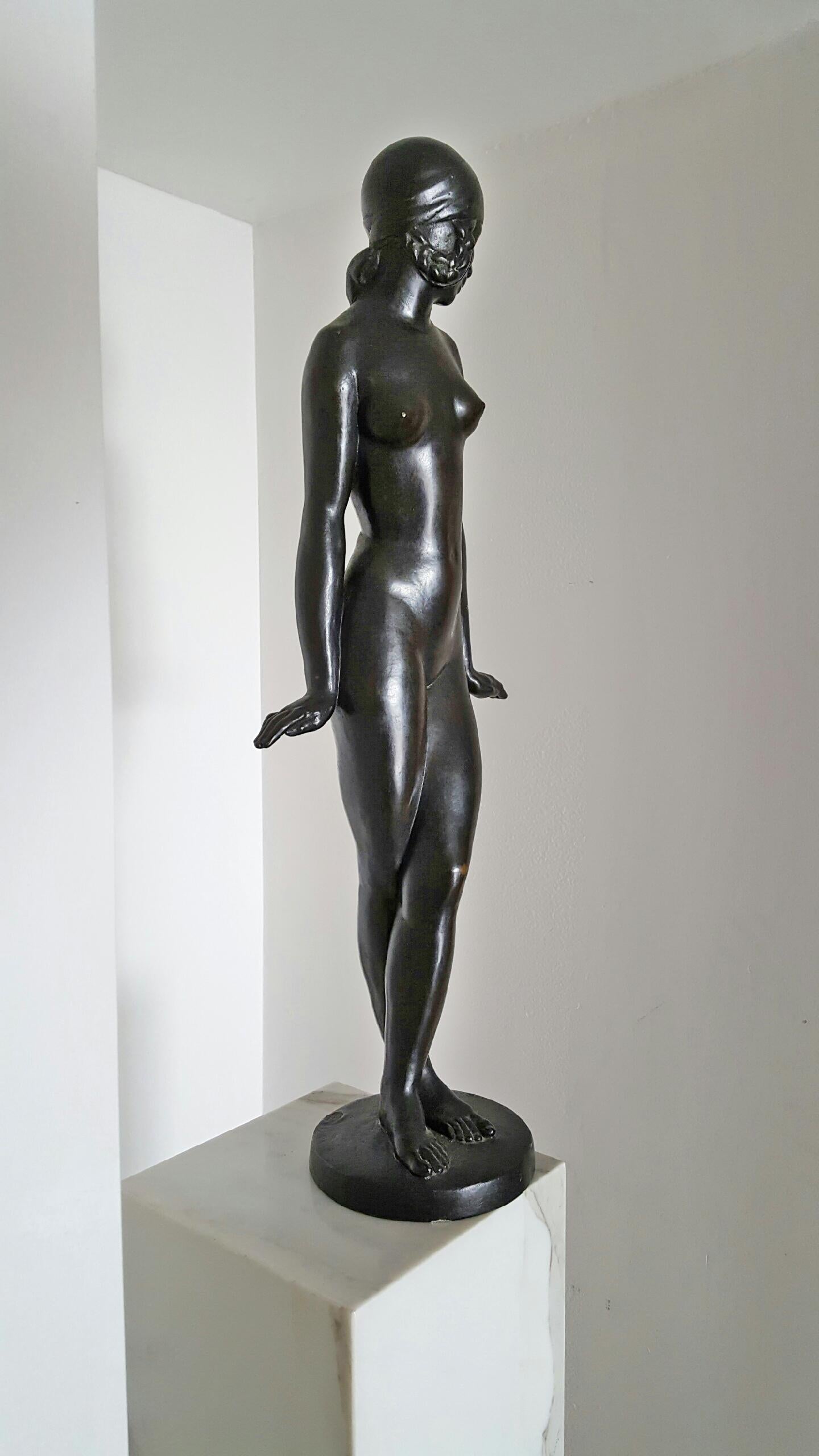Items Similar to "La Comete" Iconic French Art Deco Silvered Bronze 1920s Female Nude
Want more images or videos?
Request additional images or videos from the seller
1 of 9
Maurice Guiraud-Rivière"La Comete" Iconic French Art Deco Silvered Bronze 1920s Female Nudec. 1925
c. 1925
About the Item
"La Comete" Iconic French Art Deco Silvered Bronze 1920s Female Nude
Maurice Guirard-Riviere (1881 - 1947)
La Comete
Silvered bronze
23 inches wide x 19 3/4 inches high x 5 1/2 inches wide on a
1 1/4h black marble base
Signed in the bronze Guiraude Riviere and stamped Etling, Paris
La Comète is a magnificent Art Deco sculptural image of a female nude modeled as a streamlined comet, her long hair trailing behind her as she flies through the clouds. The silvered bronze sculpture is heightened with parcel gilding and raised on a black marble base, signed Guirard-Riviere and inscribed with the foundry mark Etling Paris. The sculpture’s composition displays a great sense of dynamism and movement.
This iconic design was considered the height of modernity and an example of the model was placed in the reception of the famous Chrysler Building, New York from 1930 to 1942.
One of the most famous, iconic and most desirable Art Deco statues ever made.
BIO
Maurice Guiraud-Rivière was born in Toulouse February 10, 1881, died in 1947, and was a painter, draftsman, and sculptor.
He was a student at the Ecole Nationale des Beaux-Arts and Antonin Mercie also a native of Toulouse.
Exhibited at the Salon of French Artists from 1907, and also at the Salon des comedians.
Art Deco sculptor, author of numerous statues (bronze or type chryselephantine) mainly on the topics of women, sports, aviation or automotive.
Most of his works were edited by Etling House, which was founded in 1909, was very active in publishing and Art Deco bronzes representing many sculptors of this artistic movement.
Maurice Guiraud-Rivière is also known for its automobile mascots, an area in which it has invested heavily. He is one of the sculptors who created some of the best known mascots in the golden age of this production (1919-1930).
Bronze
23 inches wide x 19 3/4 inches high x 5 1/2 inches wide
- Creator:Maurice Guiraud-Rivière (1881 - 1947, French)
- Creation Year:c. 1925
- Dimensions:Height: 20 in (50.8 cm)Width: 23 in (58.42 cm)Depth: 5 in (12.7 cm)
- Medium:
- Movement & Style:
- Period:
- Condition:
- Gallery Location:New York, NY
- Reference Number:1stDibs: LU1156213380092
About the Seller
5.0
Platinum Seller
These expertly vetted sellers are 1stDibs' most experienced sellers and are rated highest by our customers.
Established in 2008
1stDibs seller since 2019
164 sales on 1stDibs
Typical response time: <1 hour
- ShippingRetrieving quote...Ships From: Pawling, NY
- Return PolicyA return for this item may be initiated within 3 days of delivery.
More From This SellerView All
- "Mercury" NYC 1931 Bronze 5th Ave Traffic Light Sculpture American Art Deco WPALocated in New York, NY"Mercury" NYC 1931 Bronze 5th Ave Traffic Light Sculpture American Art Deco WPA In the late 1920s, Joseph Freedlander was asked by the City of New York ...Category
1930s Art Deco Figurative Sculptures
MaterialsBronze
- 1961 Coty Award Plaque Kenneth Hairdresser Jacqueline Onassis Bronze FashionLocated in New York, NY1961 Coty Award Plaque Kenneth Hairdresser Jacqueline Onassis Bronze Fashion Bronze on wood. The wood plaque measures 12 3/4" by 20 3/4 inches. The bronze plaque itself is 13 3/4 x 8 3/4 inches and the the bronze inscription, which reads "COTY, American Fashion Critics Special Award 1961 to KENNETH of LILY DACHE...Category
1960s American Modern Figurative Sculptures
MaterialsBronze
- "Road Builder" 20th Century Modern WPA Labor Bronze WPA Depression-Era SculptureBy Max KalishLocated in New York, NYMax Kalish The Road Builder inscribed M. KALISH 23, with Meroni-Radice foundry mark, on top of base bronze with dark brown patina, on an ebonized rectangular plinth Height: 13 1/8 in...Category
1920s American Realist Figurative Sculptures
MaterialsBronze
- Industrial Machine Age American Scene WPA Mid 20th Century 1939 SF World's FairLocated in New York, NYIndustrial Machine Age American Scene WPA Mid 20th Century 1939 SF World's Fair HAIG PATIGIAN (American/Armenian, 1876-1950) Aeronautics Pediments Two Plaster Casts, c. 1930s each 13.25 x 14.75 x 6 inches It's possible these moquettes were created for the 1939 World's Fair, the Golden Gate International Exhibition in San Francisco. Provenance: Private Collection of Lois M. Wright, Author of "A Catalogue of the Life Works of Haig Patigian, San Francisco Sculptor, 1876-1950),” 1967 Loan to Oakland Museum of California (Oakland, CA) BIO Haig Patigian is noted for his classical works, which are especially numerous in public venues in San Francisco, California. Patigian was born in Van, Armenia, which at that time was under Turkish rule. Haig was the son of Avedis and Marine Patigian, both teachers in the American Mission School there. He and his older brother showed an aptitude for art early on and were encouraged by their parents. Their father himself had taken up the new hobby of photography. The 1880s were harsh times, however, for many Armenians under an oppressive rule by the Turkish government. Many people were fleeing to the safety of the United States. Suspicious Turkish authorities accused his father of photographing city structures for the Russian government, and in 1888 he fled for his life to America. Haigs father made his way to Fresno, California, and began life anew as a ranch hand. Within two years he sent for his wife, as well as Haig, his three sisters and brother, and in 1891 the Patigians made the journey from Armenia. Haigs father, an industrious man, worked on various farms, and eventually bought his own ranch and vineyard. It was among fertile farmland of Fresno that Haig grew up. Young Haigs education consisted of teachings by his parents and by intermittent attendance in public schools. Although he had dreams of becoming an artist, he did not have the opportunity for formal study of art, and began working long days in the vineyards around Fresno. At age seventeen, Haig made a step towards his dreams and apprenticed himself to learn the trade of sign painting. In his spare time he nurtured his interest in art by painting nature and life scenes with watercolors and oil paints. When his sign-painting mentor left Fresno, Haig opened his own shop and made a name for himself in the town. San Francisco, in the meantime, had been attracting artists since the Gold Rush and had become a thriving art center. Within a few years, Haig had put aside several hundred dollars to move to San Francisco, joining his brother who was already working there as an illustrator. In 1899, when he was twenty-three, Haig had saved enough money to enroll at the Mark Hopkins Art Institute in San Francisco. Like many aspiring artists of his time, Patigian supported himself by working as a staff artist in the art department of a local newspaper, and in the winter of 1900, nearing his 24th birthday, Haig began work for the San Francisco Bulletin, producing cartoons, black and white illustrations, as well as watercolors. In 1902 tragedy struck Haig and his family. His 29-year-old brother died of pneumonia, and then his frail mother died a short time later. Five months more saw his youngest sister, just out of high school, die too. Saddened and depressed, Haig moved out of the studio he had shared with his brother, and into a dilapidated studio in a poor section of town. During this time of sadness, Haig fed a growing interest in sculpture. In 1904 Haig created what he later called his "first finished piece in sculpture". The work, called "The Unquiet Soul", depicted a man thrown back against a rock while waves lash at his feet. The body was tense and twisted, with one hand, in Haig's own words, "searchingly leaning and clutching the rock, while the other masks his troubled head". The Press Club of San Francisco, which Haig had joined in 1901, put "The Unquiet Soul" on exhibition and local headlines proclaimed "Local Newspaper Artist Embraces Sculptor's Art", and "First Work Predicts Brilliant Future". With the support of friends and community acclaim, the young illustrator left his newspaper job and became a professional sculptor. The path of his new career was not easy though. Haig had never made much money working for the newspaper and his father needed help with growing debt from funeral expenses and business problems. From time to time Haig sold some artwork, but also occasionally borrowed from friends to pay the rent. He was the classic 'starving artist'. In the spring of 1905 a white-bearded 81-year-old stranger knocked on Haig's door. It was George Zehndner, from Arcata, California. Zehndner had been born in Bavaria, Germany in 1824, the son of a farmer. In 1849 he had come to America looking for prosperity, settling in Indiana, where he worked on a farm and learned English. He found his way to the West Coast in 1852. Penniless, he worked in various jobs from San Francisco to Sacramento, then found some luck working in the gold fields of Weaverville in Trinity County, and eventually moving to a farm on 188 acres near Arcata. In his 77th year in May of 1901, Zahndner had taken a trip to San Jose, where he stood in a crowd to see a man he thought much of, President William McKinley. McKinley was popular as 'the first modern president' partially because he realized going out to meet the common person increased his support. In September of that year, however, an anarchist assassinated the president while he stood in a receiving line at the Pan-American Exhibition in Buffalo, New York. Soon after, the city of San Jose erected a statue of the slain president in St. James Park. Zehndner took a second trip to San Jose where he visited the McKinley monument. Touched, Zehndner decided that, no matter the cost, his town of Arcata too would memorialize McKinley. George Zehndner had read about Haig in a newspaper article and asked if Patigian would create a heroic statue of the late President McKinley for Arcata. When asked how much it would cost, Haig responded, despite his borderline poverty, with the fabulous sum of $15,000. Zehndner agreed. The President was to be portrayed standing, wearing an overcoat, with his feet planted squarely on the ground. In the finished statue, one hand is held out before him in a typical posture of speaking, with the other hand holding the speech as his side. The 9-foot statue...Category
1930s American Modern Figurative Sculptures
MaterialsPlaster
- 2 Sculptures: "The Power" & "The Glory" WPA Depression WWII era mid 20th centuryBy Agnes YarnallLocated in New York, NY2 Sculptures: "The Power" & "The Glory" WPA Depression WWII era mid 20th century by Agnes Yarnall circa 1940s. Sculptor, painter, poet and artistic historian, Agnes Yarnall has, since the age of six been breathing life into her art. Renowned as a sculptor, whose commissioned portrayals of contemporary celebrities are prized. She has sculpted Judith Anderson, Edna St. Vincent Millay, Carl Sandburg...Category
1940s American Modern Figurative Sculptures
MaterialsPlaster
- "Pioneer Family" WPA American Modernism Plaster Maquette Realism 20th CenturyBy William ZorachLocated in New York, NY"Pioneer Family," 23 1/2 x 16 1/4 x 10 3/4 inPlaster. c. 1927. Unsigned. Realism The Smithsonian has a cast of this sculpture in its collection. Pictured on the cover of “The Sculpt...Category
1920s American Modern Figurative Sculptures
MaterialsPlaster
You May Also Like
- Roaring LionnessLocated in Gent, VOVA fine quality, twentieth-century bronze model of a roaring lioness by Alberic Collin (Belgian 1886-1962). Prior to casting by the Valsuani foundry it w...Category
1930s Art Deco Figurative Sculptures
MaterialsBronze
- French Art Deco Bathing Nude Female Statue by Guillaume Dumont 1923Located in Oakland, CAThe French Art Deco Bathing Nude Female Statue, crafted by the Belgian sculptor Guillaume Dumont in 1923, is a testament to his artistic brilliance. Dumont, born in 1889, though the ...Category
1920s Art Deco Figurative Sculptures
MaterialsBronze
- Nude Girl Venus doves grapes Art Deco Vénus Bronze colombes aux raisinsBy Auguste Gilbert PrivatLocated in Miami, FLWonderful deep rich green patina, signed and dated on base lower right Alexia Rudier FoundryCategory
1920s Art Deco Nude Sculptures
MaterialsBronze
- Art Deco Sculpture - Art Deco Bronze, Nude Venus doves grapesBy Auguste Gilbert PrivatLocated in Miami, FLThis Art Deco bronze Nude Venus doves and grapes are a perfect artistic statement depicted in a wonderfully stunning deep rich green patina. This appears to...Category
1920s Art Deco Nude Sculptures
MaterialsBronze
- Art Deco Bronze , French Nude Girl Dancer DanseuseBy Francois Emile PopineauLocated in Miami, FLFeminine Nude Bronze with black patina Signed on Base 31 inches Paris Listed in Major Art books Iconic pose of both arms pressed close to the body with ...Category
1930s Art Deco Nude Sculptures
MaterialsBronze
- JobBy Donald De LueLocated in Boston, MAEdition of 12. Signed and inscribed on front right of base: "De LUE sc '86 © 1987 4/12 Tx". Cast at the Tallix Foundry in Beacon, NY. "Job, as much as any work of De Lue, shows t...Category
20th Century Art Deco Nude Sculptures
MaterialsBronze




